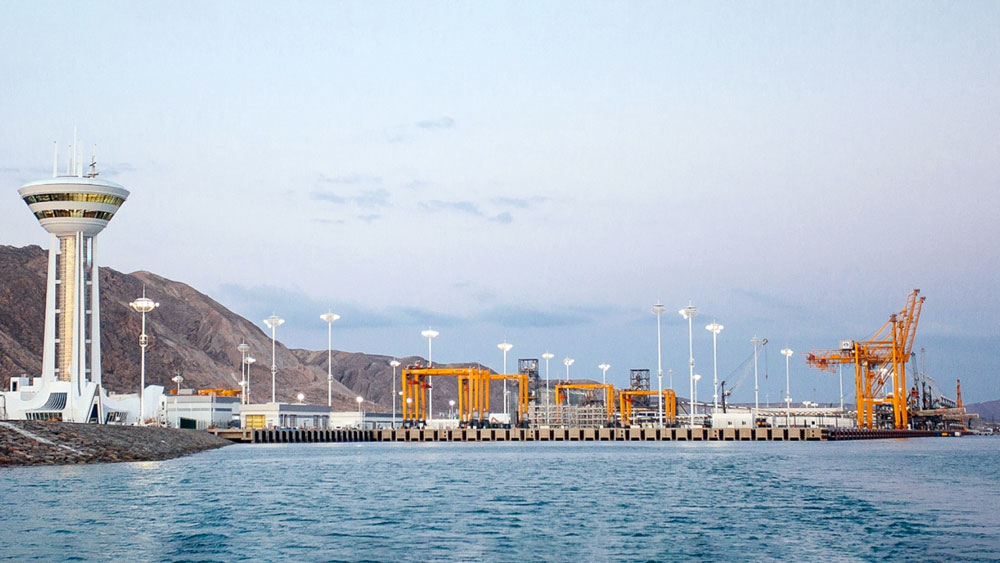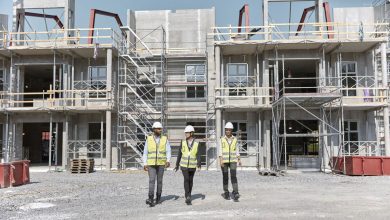Into the heart of the Great Silk Road
Towards the new frontiers of development
The Turkmenistan International Port was inaugurated on May 2, 2018, during a large ceremony, in the presence of Turkmenistan President Gurbanguly Berdimuhamedov. The conference that preceded the official opening ceremony of the port, ‘The Great Silk Road – Towards the New Frontiers of Development’, took place in the Turkish tourist region of Avaza and addressed the prospects of a new Silk Road. The building has entered, since its inauguration, the Guinness Book of Records, with the titles of “the largest port below the sea level” and “the largest artificial island below the sea level”. The Guinness World Records diplomas have been offered to the head of the Turkmen state at the conference in Avaza.
Before the official inauguration, a conference with wide international participation took place in the conference room of the ultramodern exhibition centre in the locality. More than 250 delegates from all over the world have debated the need for this investment that will facilitate economic development not just regionally, but even globally. The event ended with a spectacular sound and light show, but also a visit to the port, and President Berdimuhamedov symbolically pushed the button through which the new investment was officially inaugurated.
“We believe that it is time to lean very seriously and with great attention on the revival of the great Silk Road and we need to look at all the possibilities this road offers. The Great Silk Road does not mean just transport between different geographic areas, it also aspires to bring a solution to political, humanitarian issues and tries to change the world vision. The Great Silk Road was created to unite the East and the West, different people from different continents, built on the concept of mutual respect and trust, and to facilitate understanding between our countries, our opening, and Turkmenistan is at the heart of the Great Silk Road. Our country is based on the principle that Central Asia is a major and intangible part of the Great Silk Road, taking into account various historical, geopolitical and economic factors, and this region continues to play a special role not only at continental level, but also at global level. We are convinced that the revival of the Great Silk Road is not possible without Central Asia. On these lands, centuries ago, the caravans were passing (…). Our goal is to revive this role of Central Asia in new conditions,” President Gurbanguly Berdimuhamedov pointed out.
The head of the Turkmen state has thus highlighted some of the areas to be connected by the new port to the Caspian Sea. “We are talking about building a complex transport and transit infrastructure with access to the maritime terminals of the Black Sea, the Baltic area, South and South-East Asia and the Near East. (…) This project takes into account that in the future it will be connected with transport infrastructure to the South and to the East, to economic powers such as China, India, Pakistan and the South Pacific countries. This port is included in a broader format of cooperation that will be an example of truly innovative thinking in the global economy, a strategic perspective for development,” the head of state said.
In the Guinness Book since the inauguration
The Turkmenbashi International Port has entered, since its inauguration, the Guinness Book of Records, with the titles of “the largest port below the sea level” and “the largest artificial island below the sea level”.
The Caspian Sea Port has 1,358,484 square meters, and the artificial island, created from the excavated soil – 1,692,761 square meters. The island is a habitat for 300 species of migratory birds. The port was built during 2014-2018, with a total budget of over USD 1.5 billion. The project is implemented by the Turkmen state and was executed by Turkish company Gap Insaat. The equipment in the port has the capacity to process 12,000 tons of steel per year, the shipyard being able to build four new ships a year and repair up to 20 ships. The capacity of the cargo (general) terminal is 4,000,000 tons per year. The terminal dedicated to passenger transport covers a capacity of 300,000 people and 75,000 vehicles per year. The port is an alternative for freight transport between China and Europe. At present, the authorities involved in the project show, 95% of the freight transport between China and Europe is achieved on average in 45 days. With the opening of the port, shipment between the same regions will be reduced to 15 days.
Turkmenbashi is a locality in Turkmenistan, a port to the Caspian Sea, in the Balcan province. During the Russian Empire and the Soviet Union, the name was Krasnovodsk (Red Water City), translation of the local name Turkmen Kizil Su (Red Water). After the breakup of the Soviet Union and obtaining the independence by Turkmenistan, under the regime of Saparmurat Niyazov, the city received in 1993 a new name: Türkmenbașy (Head of the Turkmen). Here is a museum of history and natural history, and close to the city there is a great natural reserve. Oil processing, food industry (especially fish and fish processing), light industry and shipyards are the economic base of Turkmenbashi. It is linked to the capital of Ashgabat via an airline. The city of Turkmenbashi is at the end of the Trans-Caspian railroad, which connects various cities in Central Asia.
The name Turkmenistan derives from Persian, meaning “the land of the Turkmen people”. The capital is the city of Ashgabat, the Persian place-name, translating approximately as “the city of love”. It can be said that Turkmenistan’s history spans over millennia, as archaeological vestiges of 5,000 years have been discovered in the country.
Turkmenistan has a remarkable position, the fifth on the list of the fastest growing gross domestic product in the world. Although rich in natural resources in many of its areas, most of the country is covered by the Karakum desert.
The country, which neighbours Iran and Afghanistan, holds the world’s fourth-largest natural gas reserves and possesses vast reserves of oil in the Caspian basin, estimated at 12 billion tonnes. An 800-km (500-mile) pipeline is already being built from the country’s giant Galkynysh gas field, the world’s second-largest natural gas deposit, to Turkmenbashi to lessen dependence on exports to Russia.
The new port in Turkmenbashi will be used to export oil products, liquefied gas and textiles. Japan, Russia, Turkey, Iran, Uzbekistan, Azerbaijan and other countries buy polypropylene from Turkmenistan. Gas exports are also Turkmenistan’s main source of hard currency. They took a hit when Russia, once its main customer, stopped all purchases in 2016 after a pricing dispute. The new port will more than triple Turkmenistan’s cargo handling capacity to 25-26 million tons a year, the government said.
Although it has no outlets to the world’s oceans, the Caspian Sea is an important thoroughfare for trade and passengers in the region.
With the operation of Turkmenbashi port, delayed projects like the Turkmenistan-Afghanistan-Pakistan-India (TAPI) gas pipeline will gear up due to an increase in trade activities and the new route functioning in this region.
The operation of Turkmenbashi will connect four ports in three countries (Turkmenistan, Azerbaijan and Georgia), exemplifying a wonderful combination of road-to-road, road-to-sea, and sea-to-road cargo transportation.
Goods from China reach Turkmenbashi, and from there it will be transported through the Caspian Sea to Baku port in Azerbaijan. Azerbaijan’s Baku-Tbilisi-Kars (BTK) railway has become Central Asia’s gateway to Europe. The line is part of the Trans-Caspian Transit Corridor (TCTC) and was initiated by Azerbaijan’s President Ilham Aliyev and inaugurated in October 2017.
Through the Baku-Tbilisi-Kars (BTK) railway, these goods enter Georgia at two main ports – Poti and Batumi – and then onwards to Turkey and Europe. The connection of these four ports with an influx of Chinese trade will help these countries enhance their economies through various means.
The Turkmenbashi port will be a substantial asset to the Silk Road by opening new horizons between China and Europe, a rail corridor and Transport Corridor Europe-Caucasus (TRACECA), operating from western China through the Central Asian countries on its way to Europe.
Turkmenbashi International Seaport data & figures
Within the scope of the project ‘Turkmenbashi International Seaport’ constructed in Turkmenistan, ship building and ship repairing yard, ferry and passenger terminal, container terminal, general cargo terminal and bulk cargo terminal are built and Ro-Ro and polypropylene terminal is expanded.
Implementer: Turkmen State Service of Maritime and River Transport of Turkmenistan
Contractor: Gap Insaat company (Turkey)
Construction period: 2014-2018
Budget: 1.5 billion USD
Total area of the seaport: 1,358,484.31 m2
Reclaimed area: 1,121,263 m2
Quay length: 3,616 meters
Steel pipe pile: 109,240 meters
Deep foundation pile: 252,566 meters
Total indoor area of buildings: 171,085 m2
Cranes & equipment: 1,030
Total area of the artificial island: 1,692,761 m2
LOT 1: Ship building and ship repairing yard
The total area of the project is 166,000 square meters. Having the capacity to process 12,000 tons of steel per year, the yard is able to build 4 new vessels and to repair up to 20 vessels. The yard is equipped with the ship lift with the lifting capacity of 10,000 tons, two rail-based cranes with the capacity of 42 tons and one with the capacity of 84 tons, and 2 wheel-based portal cranes with the capacity of 64 tons.
The new ship building and ship repairing yard will make it possible to conduct repair works and satisfy all service needs of the vessels of the national fleet sailing under the state flag of Turkmenistan, recreational vessels and yachts for guests coming to national touristic zone ‘Awaza’, fishing vessels and support vessels of companies of the oil and gas industry operating in the Turkmen sector of the Caspian Sea.
LOT 2-6: Ferry and passenger terminal
The total area of Ro-Ro Ro-Pax Ferry terminal is equal to 230,000 square meters. The terminal is capable to service about 300,000 passengers and 75,000 vehicles per year.
The terminal main infrastructure consists of terminal building with the capacity of 800 passengers, a hotel for 50 guests.
The total berth length is equal to 256 meters, one side of the berth is a railroad platform for train and the other side will service vehicles.
Together with the renewed ferry berth, the new terminal will be able to service 4 ferries at the same time and provide a high-quality service for the passengers and vehicles travelling among the seaports of the Caspian Sea.
LOT 3: Container terminal
The total area of container terminal is equal to 249,000 square meters. Being capable to handle 400,000 20-feet containers per year, the new container terminal will contribute a lot to the development of the export, import and transit logistics infrastructure of Turkmenistan, connecting the rail, air and sea lines.
The total berth length is 480 meters, thus making it possible to carry out cargo handling operations of 3 vessels with the deadweight up to 5000 DWT each at the same time.
The terminal has 2 ship-to-shore (STS) cranes with the lifting capacity of 70 tons each, capable to process 30 containers per hour, 2 rail-based cranes with the lifting capacity of 48 tons each, and 6 wheel-based cranes with the lifting capacity of 45 tons each, as well as container moving and stacking vehicles.
The terminal has the sheltered storehouse with the total area of 9,984 square meters, sorting storehouse with the total area of 3060 square meters, and other open areas.
LOT 4: General cargo terminal
The total area of the general cargo terminal is equal to 261,000 square meters. The total handling capacity of the terminal is equal to 4,000,000 tons of general cargo per year, and its build with the purpose to handle materials such as steel, wood, equipment, vehicles and heavy cargos. The total berth length of the general cargo terminal is equal to 625 meters and it is to process 4 vessels at the same time with deadweight up to 5,000 DWT each.
Terminal will operate 6 portal cranes with the lifting capacity of 42 tons, 2 mobile cranes, and 1 wheel-based crane with the lifting capacity of 84 tons, and the terminal is provided with the vehicles for cargo transportation.
The terminal has the open storage area of 75,000 square meters and covered storehouse with the total area of 26,394 square meters.
LOT 5: Bulk cargo terminal
With the total handling capacity of 3,000,000 tons of cargo per year, the bulk cargo terminal is built to charge, discharge and store bulk cargos such as iron ore, cement, epoxide, coal, food, grain crops, sugar, salt and others. The total length of the berth is equal to 440 meters. The terminal will be able to process 3 vessels at the same time with deadweight up to 5,000 DWT each. The terminal is equipped with 3 rail-based cranes with the lifting capacity of 42 tons, 2 conveyor belts with the loading/unloading capacity of 650 tons of bulk cargo per hour, 5 wheel-based loaders with the capacity of 20 tons, and 1 mobile crane with the lifting capacity of 20 tons. The terminal has the open storage area of 37,000 square meters and a covered storehouse with the total area of 8,512 square meters.
LOT 7: Polypropylene terminal
The total area of the polypropylene terminal is equal to 62,000 square meters. The handling capacity of terminal is equal to 120,000 tons of polypropylene per year. Having the total berth length of 750 meters, the terminal will be able to process 3 vessels at the same time with deadweight up to 5,000 DWT each. The terminal is equipped with 2 rail-based cranes with the lifting capacity of 64 tons each.







